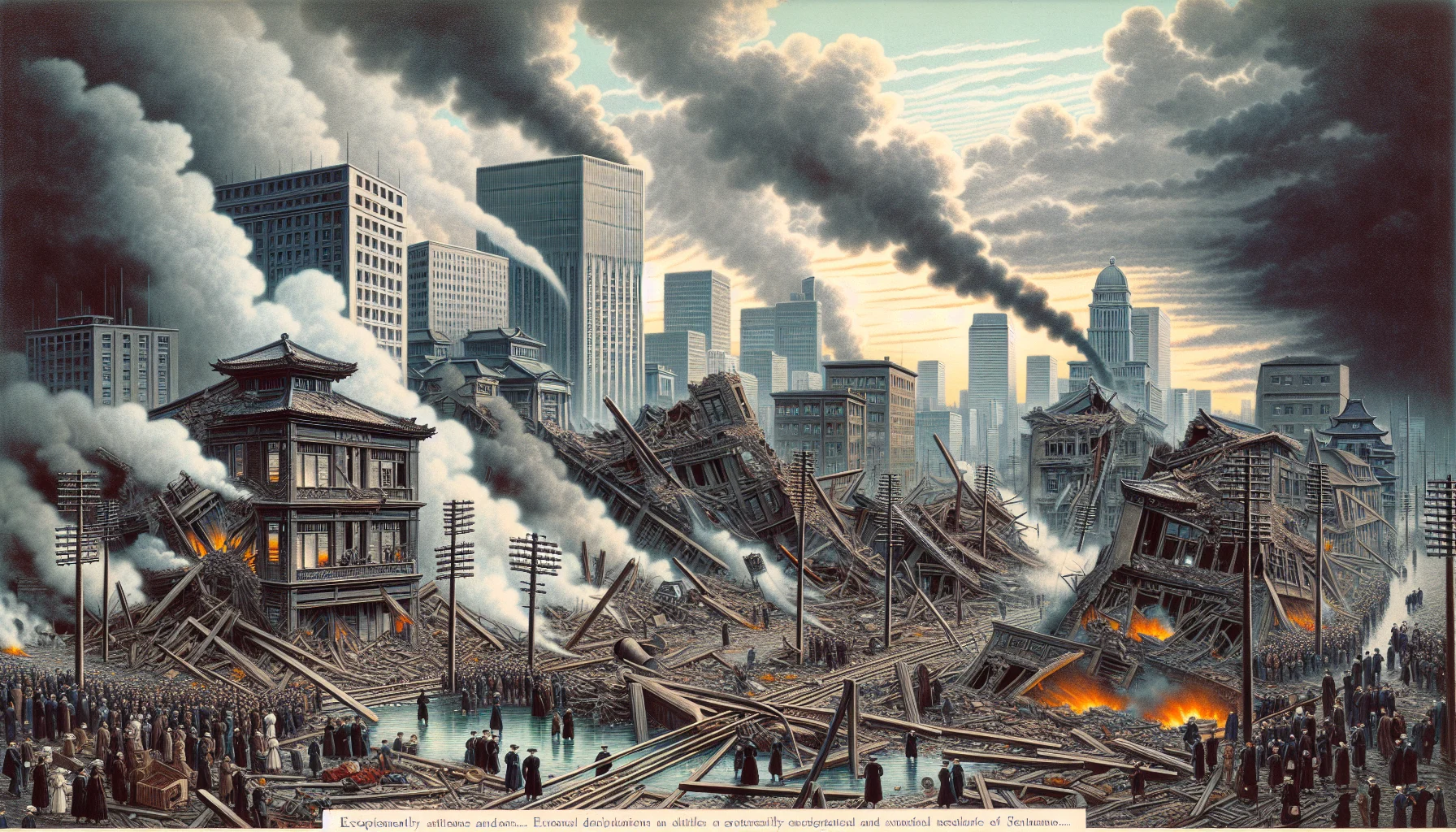
The Great Kantō Earthquake
by: The Calamity Calendar Team
September 1, 1923
The Dawn of Destruction
On the cusp of a new era, when Tokyo was burgeoning into a modern metropolis, nature's wrath struck with a power unforeseen. Known as the Great Kantō Earthquake, this catastrophic event indelibly marked September 1, 1923, as one of the darkest days in Japan's history. It was just before noon, at 11:58 a.m., that the tectonic plates beneath Honshu grumbled, igniting a chain of destruction that would echo through generations.
The earthquake, measuring a staggering 7.9 magnitude, unleashed its fury upon the Kantō region. Its immense power was so crippling that it rendered two of Japan’s key cities—Tokyo and Yokohama—into scenes of chaos and unimaginable devastation. These cities, epitomes of Japan's modernization after the Meiji Restoration, were thriving in political and economic vigor, celebrated for their cultural and industrial advancements. Yet, beneath this veneer of progress lay a hidden vulnerability, as their burgeoning infrastructures were ill-prepared for the seismic event that now unfolded.
A City Engulfed
In the moments following the initial tremors, the true extent of the disaster began to manifest. The quake persisted, accompanied by aftershocks that seemed relentless. Those who managed to escape their crumbling homes and workplaces faced new horrors as fires erupted throughout the ruins. The urban sprawl, dominated by wooden constructions, provided ample fuel, and with the aid of strong winds, many fires spiraled into uncontainable infernos.
Tokyo, with its densely packed districts, witnessed blazes that swept rapidly from one neighborhood to another, turning escape routes into corridors of flames. The Ryōgoku district bore witness to one of the most harrowing tragedies. Thousands sought refuge in open spaces, only to find themselves encircled by fire. Trapped, around 38,000 souls tragically lost their lives in this one locale alone, a microcosm of the broader calamity.
The Tsunami’s Terror
Meanwhile, the very geography of the region turned against its inhabitants. The quake's epicenter in Sagami Bay caused a massive seafloor displacement, and in its wake, a tsunami rose to formidable heights. Towering waves of up to 12 meters crashed ashore, amplifying the destruction on coastal areas already reeling from the earthquake's impact.
Urban Ruin in Its Wake
As September passed its first dawn into dusk, the extent of the devastation could finally be surveyed. Infrastructure crumpled like fragile toys under a giant’s foot. The telegraph lines that once buzzed with communications fell silent. Railways twisted and cracked, standing useless amidst the wreckage. Vital services were not just disrupted; they were obliterated.
Thanks for subscribing!
In the wake of the disaster, official estimates reported over 575,000 homes either obliterated or significantly damaged. This widespread ruin gave rise to tent cities and makeshift shelters, as vast numbers of survivors were left homeless in the disaster-ravaged region. The streets of Tokyo, once bustling with industry and life, now bore a mournful silence, punctuated only by the cries of those searching for missing loved ones.
Human Toll and Heartache
The human cost was as staggering as the physical destruction. The Great Kantō Earthquake claimed more than 140,000 lives, a number including those injuries and the many presumed missing. Hospitals swiftly overflowed with the wounded, as doctors worked tirelessly amid bleak conditions. Though medical personnel and surviving aid workers persisted heroically, the severity of wounds and sheer number of patients overwhelmed relief efforts.
Despite these efforts, the slow governmental response was a point of severe criticism in the days following the disaster. Communication breakdowns and damaged infrastructure severely hampered coordination and deployment of aid. The Japanese government struggled to cope with both the immediate humanitarian crisis and the longer-term challenge of a nation now grappling with profound loss.
Resilience in Rebuilding
While the immediate aftermath was grim, a spirit of resilience began to show in the ensuing weeks and months. The disaster was a crucible from which a stronger, more resilient Japan would emerge. Relief operations gained momentum, spearheaded by military involvement to restore order and provide essential supplies. Refugee centers were established, becoming havens for displaced families seeking solace amid chaos.
In the long run, the earthquake spurred significant changes in urban planning and architecture. Learning hard lessons from the past, new legislation was introduced mandating earthquake-resistant designs for buildings, transforming the landscape of Japanese cities forever. This era also witnessed the birth of the Fire and Disaster Management Agency, an institution dedicated to ensuring that such unpreparedness would never again be a defining feature of Japanese disaster management.
Legacy and Learning
The legacy of the Great Kantō Earthquake extends beyond tangible reconstructions, found also in the poignant tales of personal bravery and community unity. It sparked an enduring commitment to understanding and preparing for seismic threats, influencing not only Japan but global standards of earthquake preparedness.
Modern Japan still reveres the memories of those lost, reflected in annual memorials that pay homage to the resiliency of its people. Advanced seismic technologies developed from the knowledge gained then ensure that future generations remain acutely aware and alert to the earth’s potential fury.
In examining the social and political shifts that followed the earthquake, one cannot overlook its role as a catalyst for profound change, not only in infrastructural terms but also within the societal and cultural fabric of Japan. This cataclysmic event indelibly shaped the nation’s trajectory, reinforcing both a caution and resilience that have come to define the Japanese spirit.
Stay in the Loop!
Become a Calamity Insider and get exclusive Calamity Calendar updates delivered straight to your inbox.
Thanks! You're now subscribed.